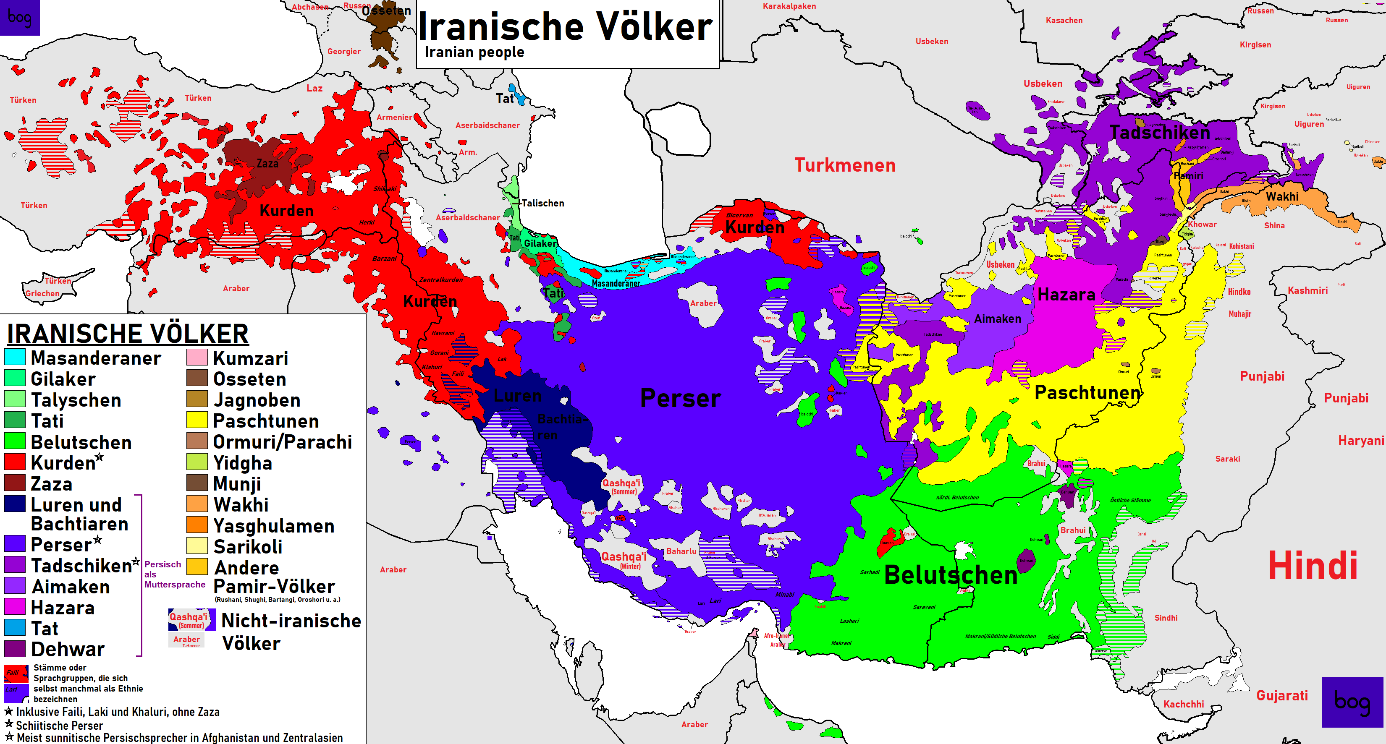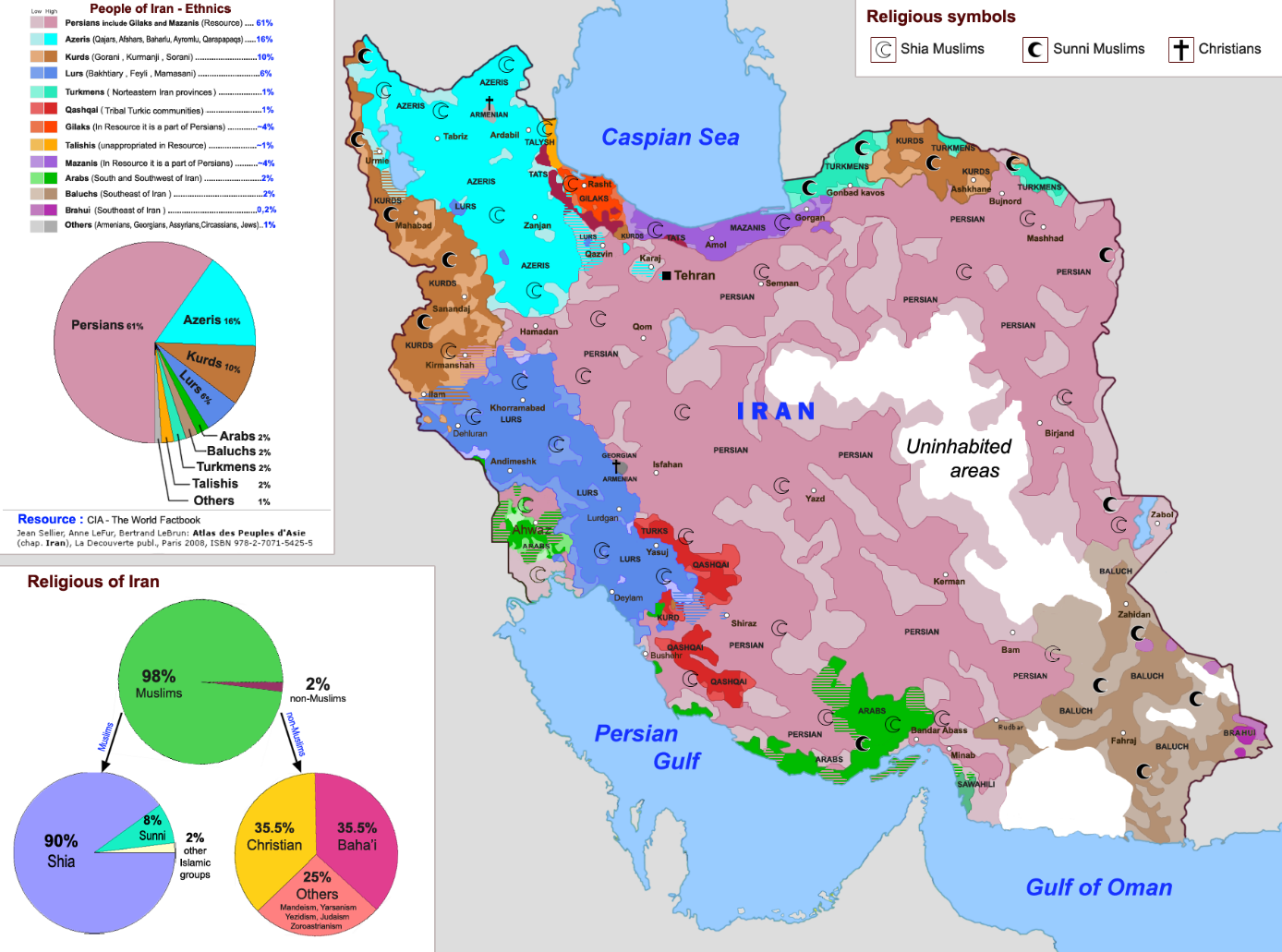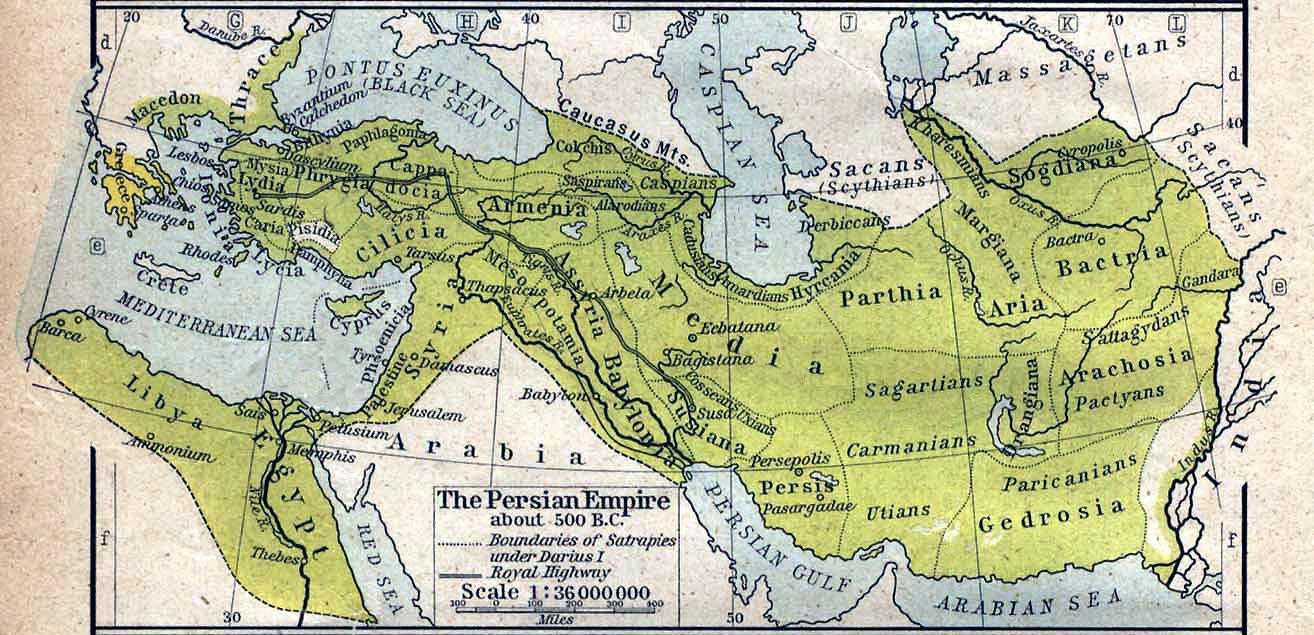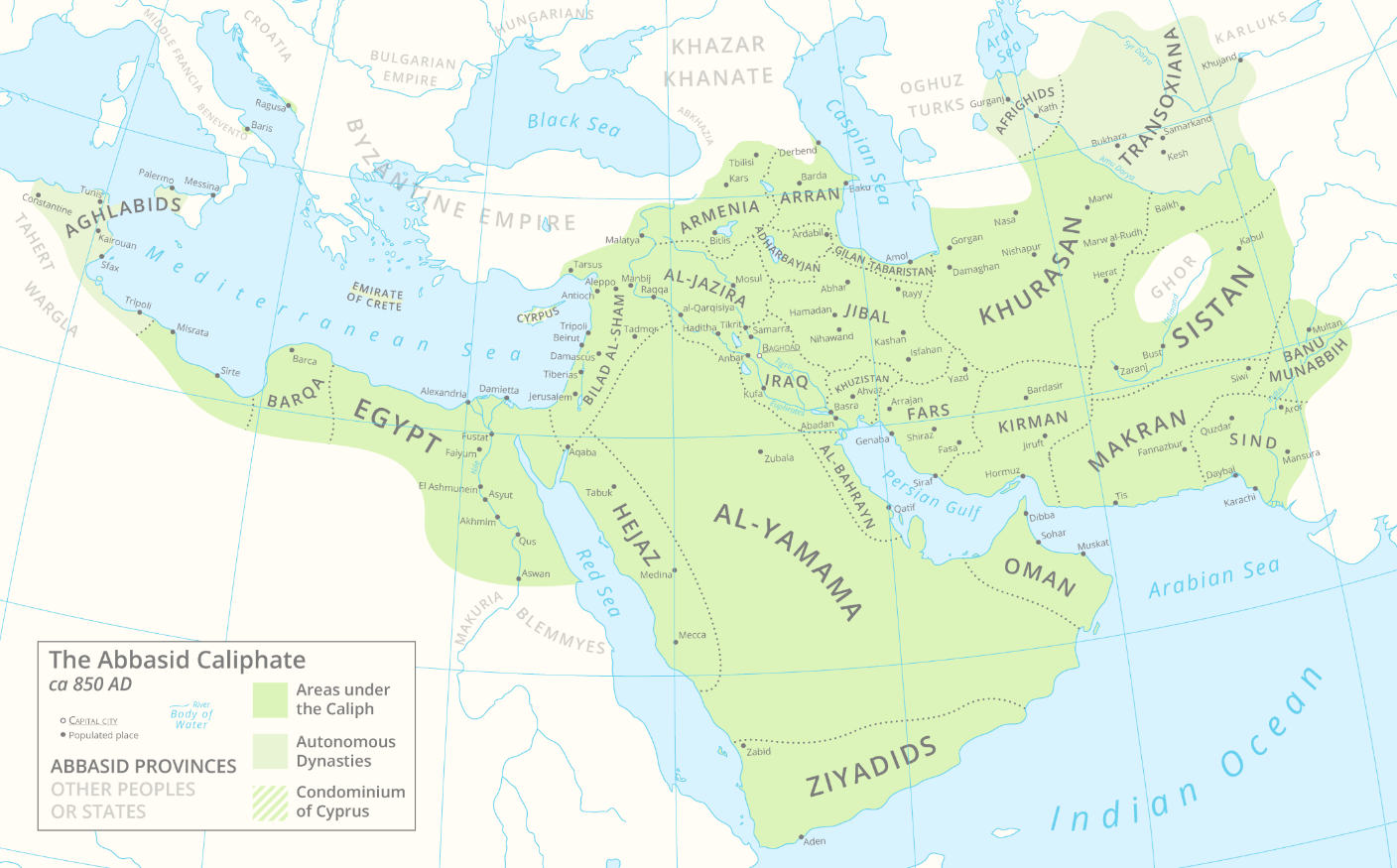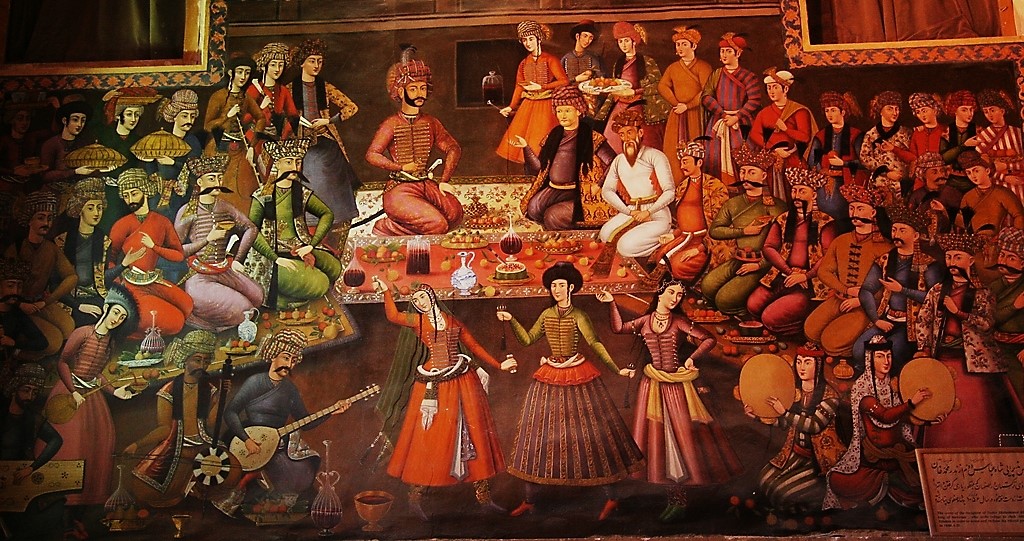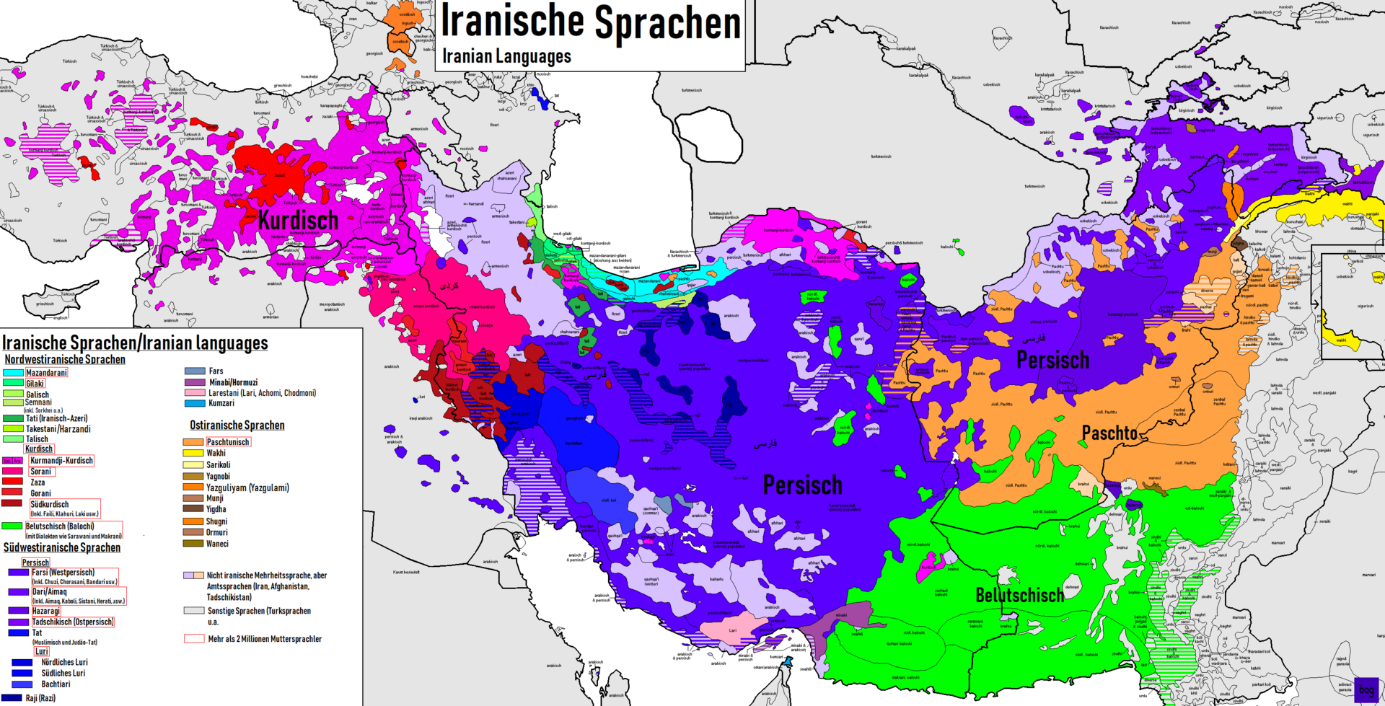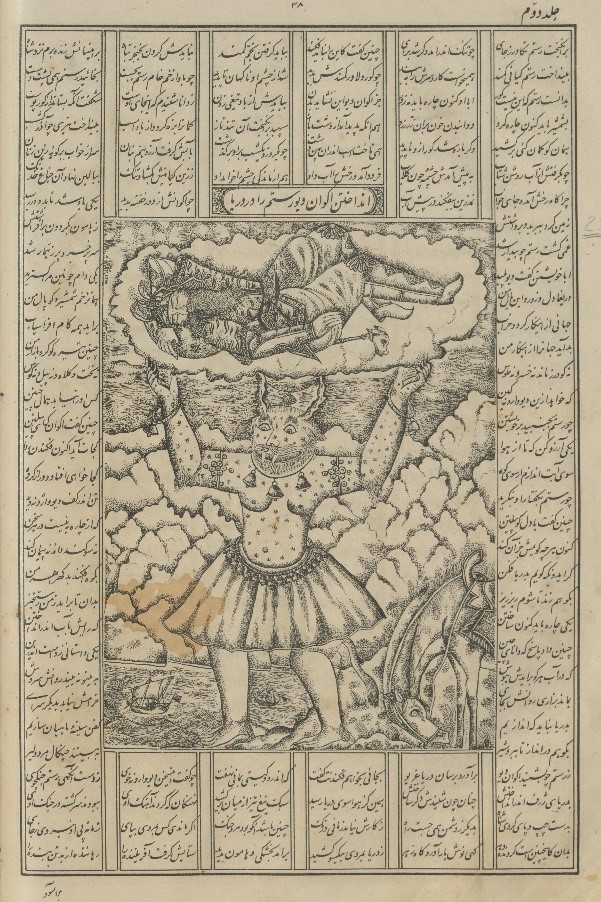Our FID Middle East, North Africa and Islamic Studies acquires subject-specific publications from the countries of the MENA region and thus supplies various subjects such as Caucasian Studies, Arabic Studies, Islamic Studies, Turkology, Kurdology as well as Iranian Studies.
Iranian Studies is an interdisciplinary cultural science that deals with the history, society, language and religion of the Iranian cultural area, from antiquity to the present. The issues dealt with extend beyond the borders of present-day Iran and its neighbouring countries to Syria, Georgia, Uzbekistan, Tajikistan and India in Central and South Asia.
Iranian studies examines both the intellectual and material cultural heritage of the Iranian peoples and has points of contact with other subjects such as philology, cultural anthropology, archaeology, history and religious studies.
Iran today
Iran is a country in Western Asia and covers an area of about 1.6 million square kilometres. It borders the Caspian Sea to the north with neighbouring Turkmenistan, Azerbaijan and Armenia, Iraq and Turkey to the west, Afghanistan and Pakistan to the east and the Persian Gulf and Oman to the south. Iran comprises diverse landscapes such as mountains, deserts, plains and coastal strips. While the central and eastern regions are characterised by deserts such as the Dasht-e Kavir and the Dasht-e Lut, the west and north of the country are home to the Zagros Mountains and the Elburs Mountains, respectively, which reach heights of over 5,600 metres.
Contemporary Iran is home to a population of more than 88.6 million people, with the capital Tehran having a population of about 8.7 million. The official language of the country is Persian (Farsi), yet there are many other Iranian languages still spoken in Iran and outside; such as Ossetian, Tati, Talysh, Hazaragi, Aimaq, Pashto, Judeo-Persian, Luri, Balochi, Mazandarani, Yaghnobi as well as Azerbaijani (Azari), Arabic and Kurdish (Kurmanji, Sorani, Gorani, Zazaki). These languages have their own dialects and cultural differences, but contribute to the linguistic diversity of the country and the region.
Iran is a diverse country with a number of ethnic and religious minorities. The majority of the Iranian population officially belongs to Shiite Islam. However, there is also a sizeable Sunni minority, particularly among the Kurds, Arabs and Baluchis. Other religious minorities in Iran include the Bahai, Christians, Jews and Zoroastrians.
Baháʼí Faith has its roots in 19th century Iran and, although often subject to discrimination and persecution, the Baha’i are one of the largest religious minorities in Iran. Christian communities in Iran include Armenians, Assyrians, Chaldeans and Protestants. The Jewish community in Iran is one of the oldest in the world and has a long history in the country.
The largest ethnic minority in Iran are the Azerbaijanis, who live mainly in the northwestern provinces of the country. They make up about 16 per cent of the population and speak Azerbaijani (Azari), a Turkic language related to Turkic. Other significant ethnic minorities in Iran are the Kurds and the Lurs, who live mainly in the northwestern and western regions of the country, respectively, and the Arabs, who reside in the southwestern provinces. There are also smaller minorities such as the Turkmens, Baloch, Talysh and Armenians living in different parts of the country.
History
Persia, Ancient Iran
Iran’s history stretches back through antiquity to the Neolithic period and is closely linked to various rulers and religions, which at times stretched from Thrace to northwest India in the west and to Egypt in the east. Iran was settled by humans as early as the Neolithic period, and thus the country is home to some of the oldest advanced civilisations in the world. Its settlement history can be traced back to the 8th century BC.
The first known empire on Iranian soil was Elam. An empire in the southwest of what is now Iran, it was to last from around 3,500 BC to 569 BC. The Elamites were known for their advanced architecture, art and writing systems. They also had close trade relations with other ancient civilisations such as Mesopotamia. After Elam, the first great Iranian empire developed, the Median Empire. An ancient advanced civilisation that emerged in the 7th century BC. The Medes were an Indo-Iranian people who originally lived in the region around the river Medos (now known as Dez) in north-western Iran.
After the Mede Empire, the first world empire in history was founded in the 6th century BC under the Achaemenids. The so-called Persian or Achaemenid Empire, which extended over large parts of the Middle East. The former predominant religion was Zoroastrianism (also known as Parsism). An ancient Indo-Iranian religion founded by Zoroaster, it emphasised belief in a single god, Ahura Mazda, and the struggle between good and evil. Zoroastrianism had a strong influence on Persian culture and society and also shaped later monotheistic religions such as Judaism.
After the collapse of the Achaemenid Empire in the 4th century BC, Persia was ruled by various powers, including the Seleucid Empire, Parthian Empire and Sasanian Empire. The Sasanian Empire, which lasted from 224 to 651 AD, was an important Iranian dynasty that established a strong centralised government and established Zoroastrianism as the state religion. Incidentally, the name “Iran” was first used by the Sasanians. During the Sasanian era, Iran flourished in art, architecture, literature and science. Sassanid art was characterised by magnificent palaces, monumental sculptures and elaborate murals.
Iran under Muslim rule
Islamic expansion began in the 7th century and the Arabs finally conquered Persia in 651 A.D. This marked the beginning of a new era in Iran’s history with profound changes. Islam became the dominant religion, and various Muslim dynasties ruled the country and shaped its culture, politics and society. The first important dynasty was the Umayyad dynasty, which ruled from Damascus. However, they were not very popular with the Iranian population as they were considered Arab-dominated and had little regard for Iranian culture. In the 9th century, the Abbasids came to power. They came from what is now Iraq and moved their capital to Baghdad. The Abbasids were known for their promotion of science, art and culture. Under their rule, Iran experienced a flourishing of literature, philosophy and science.
After the Abbasids, several local dynasties ruled Iran, including the Samanids. A dynasty of Persian descent from the 10th century, which played an important role in the revival of Persian culture. After the Samanids, the Seljuks became the dominant power in Iran. They were a Turkmen dynasty and brought a new wave of Islamic culture and architecture to Iran. They were known for their military strength and their promotion of trade and economy. In the 13th century, the Mongols conquered Iran, among other places, and founded the Ilkhanate. Although the Mongol conquest was initially accompanied by great destruction, they later began to appreciate Iranian culture and promoted art, literature and science.
Despite the various Muslim dominations, however, Persia maintained its own cultural identity and even contributed to the development of Islamic civilisation. Persian-speaking scholars and intellectuals, such as Farabi, Avicenna, Ghazali, Razi or Tusi, played an important role in preserving and advancing knowledge in fields such as medicine, mathematics, astronomy and philosophy.
Modern History of Iran
In the 16th century, the Safavids became the ruling power in Iran and made Shiite Islam the state religion. Over time, Shiism has developed a unique character in Iran and still plays an important role in the political and social life of the country and the Middle East. The Safavids were also known for their promotion of art, architecture and literature.
The Safavids were followed by the Qajars, a Turkmen dynasty that came to power in the 18th century and ruled until the beginning of the 20th century. Under their rule, Iran experienced political instability and territorial losses due to conflicts with European powers and the Russian Empire.
After Qajars, a major change in Iran’s history occurred with the establishment of the Pahlavi dynasty. In 1925, Reza Shah Pahlavi took power and implemented a series of modernisation measures. Already a former prime minister, he introduced the Iranian calendar after Nouruz in 1925, which, in contrast to the Islamic lunar calendar, is based on the solar year. In 1935, he made an official declaration that the country should henceforth be called “Iran” and not “Persia”. He tried to industrialise Iran, reform the education system and improve the status of women. In 1941, his son, Mohammad Reza Shah Pahlavi, took over the reigns and continued the modernisation efforts. However, the Pahlavi dynasty was also characterised by political oppression and authoritarian rule. The Shah introduced a policy of “White Revolution”, which aimed at social and economic reforms, but also led to discontent and resistance. In particular, students, intellectuals, workers, peasants and other social and political groups began to rise up against the Shah’s authoritarian rule under the leadership of Shiite clerics as well as oppositional organisations such as the Tudeh Party and the Chebhe Melli.
In 1979, the so-called Iranian or Islamic Revolution led to the overthrow of the Pahlavi dynasty and the establishment of the Islamic Republic of Iran, a theocratic government led by Ayatollah Khomeini. The latter was appointed supreme leader of the country and was replaced by Ayatollah Khamenei after his demise in 1989. Iran’s political situation and relationship with the international community are complex and highly controversial.
Language and Literature
Language
The Iranian language belongs to the Indo-Iranian language family and has a long history dating back to the first millennium BC. The oldest known form of Iranian is Old Persian, which was spoken during the Achaemenid Empire (550-330 BC). Old Persian was mainly used in inscriptions and official documents. After Old Persian, Middle Persian developed, which was spoken during the Sasanian dynasty (224-651 AD) and was also used in literature and poetry. In the meantime, many Old and Middle Iranian languages have already died out; such as Median, Parthian, Avestan, Bactrian, Khorezmian and Sogdian.
Middle Persian continued to evolve over time into New Persian, also known as “Persian”. New Persian emerged in the 9th century and is the modern form of the Persian language spoken today in Iran, Afghanistan and Tajikistan and known as Farsi, Dari and Tajiki respectively. New Persian has evolved over the centuries and has been influenced mainly by the Arabic language. After the Islamic conquest of Persia in the 7th century, Arabic became the language of government, law, religion and medicine. Nevertheless, the Persian language retained its importance and continued to develop. Already during the Abbasid dynasty (750-1258), the Persian language flourished, and scholars and lyricists were also allowed to write and compose poetry in Persian. In addition, Persian scribes (dabir) were also responsible for the administration (diwan) of the Abbasids’ royal affairs and the recording of their decrees, letters and official documents. Then in the 16th century, the Safavids (1501-1736) made Persian the official language of the empire. Under their rule, the Persian language experienced another peak and became the second most important language in the Islamic world next to Turkish.
Literature
The Persian language was able to retain its place not only because of the support it received from some of the Muslim dynasties, but also because of its deep-rooted history and culture in Iran. The Persians had a rich literary tradition before the Islamic conquest and this tradition continued despite Arab dominance.
Here, Persian lyricists in particular played an important role in preserving and promoting the Persian language over the Arabic language. One of them was the Persian poet Ferdowsi, who, however, deliberately chose to write his masterpiece Shahnameh in Persian in order to preserve Persian identity and culture. He used an archaic form of Persian in his work, which was more similar to ancient Persian than contemporary Persian. This helped to preserve the Persian language and emphasise its connection to ancient Persian culture. The Shahnameh became a symbol of national pride and Persian identity and had a great influence on the development of Persian language and literature.
Persian literature encompasses various genres such as poetry, prose, epic and drama. Persian poetry has gained worldwide recognition and famous Persian poets such as Rudaki, Rumi, Hafez, Saadi and Omar Khayyam have had a significant impact on the country’s literature and culture, and some have even left an impact on Western literature. The poems of these poets often deal with themes such as love, spirituality, nature and the search for the true meaning of life.
Irfan
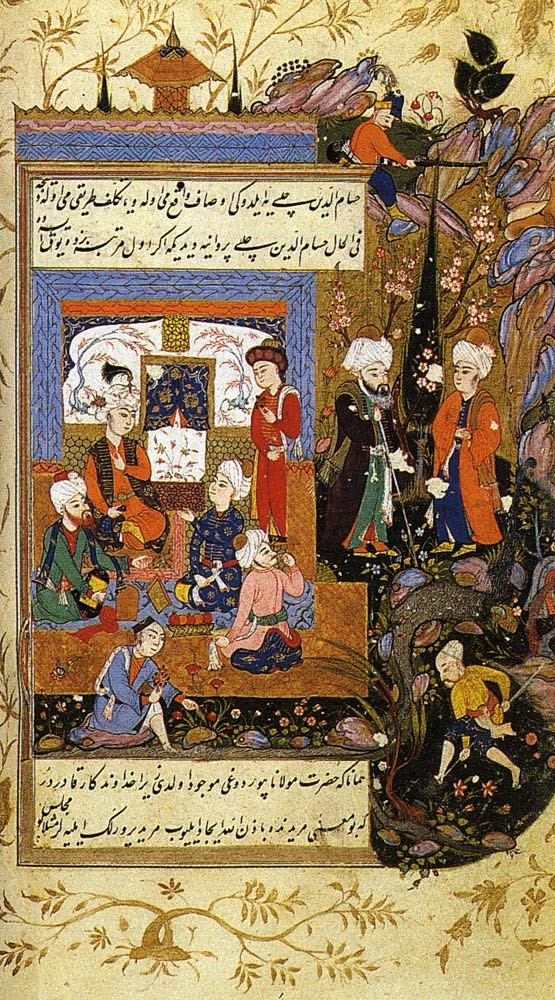 Another important aspect of Iranian culture is the Irfan, also known as Sufism, Tasawwuf or Islamic mysticism. The Irfan emphasises personal spiritual experience and the search for a direct connection with God. It is a mystical tradition based on the search for inner knowledge and spiritual perfection. The Irfan has played a significant role in Persian literature throughout history. Many Persian poets and writers have written on mystical themes and imbued their poems and stories with spiritual messages.
Another important aspect of Iranian culture is the Irfan, also known as Sufism, Tasawwuf or Islamic mysticism. The Irfan emphasises personal spiritual experience and the search for a direct connection with God. It is a mystical tradition based on the search for inner knowledge and spiritual perfection. The Irfan has played a significant role in Persian literature throughout history. Many Persian poets and writers have written on mystical themes and imbued their poems and stories with spiritual messages.
The Irfan has a broad following in Iran, but is also controversial. While some consider the Irfan an integral part of Iran’s cultural heritage, there are also conservative currents that view Sufism critically and as a deviation from orthodox Islam. For Sufism has also contributed to the development of a rich tradition of Sufi orders and spiritual masters in Iran, as with the Ni’matullāhī, Qadiriyya, and Chishti orders.
Subject bibliography of Iranian Studies
Our FID Middle East provides Iranian studies with publications, primarily in original languages:
3.2.5 Iran, Afghanistan, Tajikistan and other Iranian peoples in the region
3.2.5 Iran, Afghanistan, Tajikistan and other Iranian peoples of the region
- 3.2.5.1 The region
- 3.2.5.2 Iran
- 3.2.5.3 Afghanistan
- 3.2.5.4 Tajikistan
- 3.2.5.5 Kurds and other Iranian peoples in the region
4.4 Languages and literatures of Iran, Afghanistan and other Iranian peoples
4.4 Languages and literatures of Iran, Afghanistan and other Iranian peoples
- 4.4.1 General | MENAsearch
- 4.4.2 Iranian Languages
- 4.4.2.1 General | MENAsearch
- 4.4.2.2 Old and Middle Iranian Languages | MENAsearch
- 4.4.2.3 New Iranian Languages
- 4.4.3 Iranian Literatures
Further links
Where can I study Iranian Studies in Germany?
